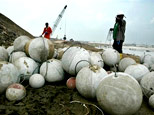I have a baaaaaaaaaaaaaad feeling about this……. . 


How do you stop an Indonesian volcano from oozing hot mud?
With giant concrete balls.
With giant concrete balls.

Efforts to plug Indonesian "mud volcano" resume
JAKARTA (AFP) - Engineers dropped chains of concrete balls into a "volcano" oozing hot mud in Indonesia's East Java province Monday as they resumed a bid to stem the flow which has submerged entire villages.
"We have been able to insert four chains of concrete balls today, before changing smoke from the hot mud forced the operations to be halted," Rudi Novrianto, a spokesman for the audacious bid to plug the crater, told AFP.
The operation to drop the chains into the main crater was halted on Saturday when a cable linking two cranes hoisting them suffered damage.
Workers had managed to insert only the first chain. Each one links together four concrete balls.
Two cranes, one static and the other movable, have been erected on both sides of the crater. They are used to drop the chained concrete balls into the hole.
Work was delayed Sunday by repairs and heavy rains, which made conditions dangerous.
"We have had good weather today," Novrianto said. But he added the operation was called off for the remainder of Monday because drifting smoke from the hot mud had begun to affect workers.
"We will see tomorrow (Tuesday) whether the winds and the weather will allow us to continue the operations," Novrianto said.
Entire villages, factories and fields have been submerged by the mud, which has forced more than 15,000 people from their homes.
The mud sprang up when exploratory drilling by the PT Lapindo Brantas energy firm pierced an underground chamber of hydrogen sulphide, forcing hot mud to the surface in Sidoarjo, East Java.
Engineers plan to drop about 375 chains of concrete balls, weighing 400-500 kilograms (880-1,100 pounds), into the 50-metre (165-feet) mud hole, under a plan devised by a local expert.
The aim is to slow the mudflow by about 50-70 percent, but there is no guarantee the experimental attempt will work.
JAKARTA (AFP) - Engineers dropped chains of concrete balls into a "volcano" oozing hot mud in Indonesia's East Java province Monday as they resumed a bid to stem the flow which has submerged entire villages.
"We have been able to insert four chains of concrete balls today, before changing smoke from the hot mud forced the operations to be halted," Rudi Novrianto, a spokesman for the audacious bid to plug the crater, told AFP.
The operation to drop the chains into the main crater was halted on Saturday when a cable linking two cranes hoisting them suffered damage.
Workers had managed to insert only the first chain. Each one links together four concrete balls.
Two cranes, one static and the other movable, have been erected on both sides of the crater. They are used to drop the chained concrete balls into the hole.
Work was delayed Sunday by repairs and heavy rains, which made conditions dangerous.
"We have had good weather today," Novrianto said. But he added the operation was called off for the remainder of Monday because drifting smoke from the hot mud had begun to affect workers.
"We will see tomorrow (Tuesday) whether the winds and the weather will allow us to continue the operations," Novrianto said.
Entire villages, factories and fields have been submerged by the mud, which has forced more than 15,000 people from their homes.
The mud sprang up when exploratory drilling by the PT Lapindo Brantas energy firm pierced an underground chamber of hydrogen sulphide, forcing hot mud to the surface in Sidoarjo, East Java.
Engineers plan to drop about 375 chains of concrete balls, weighing 400-500 kilograms (880-1,100 pounds), into the 50-metre (165-feet) mud hole, under a plan devised by a local expert.
The aim is to slow the mudflow by about 50-70 percent, but there is no guarantee the experimental attempt will work.







Comment